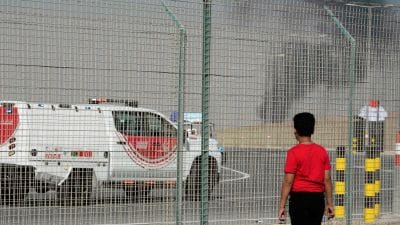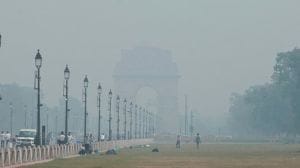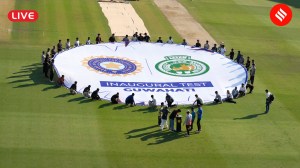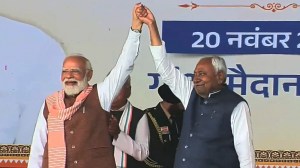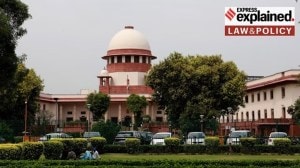The message in the Bharat Ratnas: How the politics of the honour works
Along with recognising the contribution of the recipient, the Padma and Bharat Ratna awards have always been tools for political messaging — and the Narendra Modi government has been particularly astute in making its choices.
 The Prime Minister had announced the Bharat Ratna for veteran BJP leader L K Advani on February 3, and for OBC reservations pioneer and former Bihar Chief Minister Karpoori Thakur last month.
The Prime Minister had announced the Bharat Ratna for veteran BJP leader L K Advani on February 3, and for OBC reservations pioneer and former Bihar Chief Minister Karpoori Thakur last month.Prime Minister Narendra Modi on Friday announced that former Prime Ministers P V Narasimha Rao (1991-96) and Chaudhary Charan Singh (July 1979-January 1980), and the pioneer of the Green Revolution Dr M S Swaminathan, would be conferred the Bharat Ratna, the country’s highest civilian honour.
The Prime Minister had announced the Bharat Ratna for veteran BJP leader L K Advani on February 3, and for OBC reservations pioneer and former Bihar Chief Minister Karpoori Thakur last month.
BJP signals for elections
Friday’s announcements are especially significant because they have come barely a couple of months ahead of Lok Sabha elections. By conferring the Bharat Ratna on Dr Swaminathan and Charan Singh, the government appears to be signalling it cares about farmers and agriculture.
Charan Singh is also among the tallest Jat leaders the country has seen. While Jats have stood firmly behind the BJP in Uttar Pradesh since 2014, the community is said to be unhappy with the party in Haryana.
The honour for Charan Singh coincides with the BJP’s successful outreach to the RLD, the party that is led by Jayant Chaudhary, the grandson of Charan Singh. The RLD is part of the opposition INDIA alliance, but is now set to contest the Lok Sabha elections with the BJP. Jayant said on X that the PM’s announcement had “won his heart”, and later told reporters that he no longer has the face to deny the possibility of the RLD joining the NDA.
The honour for Narasimha Rao is even more significant. It rubs in the message that the Congress had for years ignored one of its most able administrators, the man who pulled the country out of a deep financial crisis and set it on the path of economic growth, only because he had differences with Sonia Gandhi.
It also underscores the point the Prime Minister sought to make in Parliament this week — that while the BJP puts the nation above all else, for the Congress, the Nehru-Gandhi family always comes first.
The Ratna for Rao is also significant for coming soon after the consecration of the Ram Temple in Ayodhya. The Congress has been accused of putting the blame for the demolition of the Babri Masjid on Rao, who was Prime Minister at the time, by his alleged miscalculation of the situation on the ground at the time.
For Temple and Mandal
The Bharat Ratna for Advani was noteworthy given the complicated relationship that Prime Minister Modi has shared with the 96-year-old leader who was once considered his backer in the BJP but who later tried to thwart his rise.
But it was also a recognition of Advani’s role in making the Ram Temple a reality — as BJP president at the time, it is Advani who put the Ram Janmabhoomi movement at the forefront of the party’s agenda. The highest civilian honour for Advani is likely to contribute to the BJP’s narrative on the temple in the run-up to the elections.
The honour for Karpoori Thakur came at a time when the Opposition has been hoping to build its demand for a caste census into a plank that might be able to reduce the post-Ram Temple Hindutva fervour in favour of the BJP.
Recognition for the man whom Nitish Kumar and Lalu Prasad consider their political guru — but whose contribution to social justice has never been recognised by the Congress — was intended to signal the BJP’s empathy and concern for the backward castes, especially in Bihar and UP. Days after the announcement of the Ratna, Bihar Chief Minister Nitish Kumar, who had spearheaded the demand for a caste census and carried out a survey of castes in his state, shifted his allegiance to the NDA.
A history of astute choices
Along with recognising the contribution of the recipient, the Padma and Bharat Ratna awards have always been tools for political messaging — and the Narendra Modi government has been particularly astute in making its choices.
Before the announcement of these five Bharat Ratnas, the Modi government has conferred the honour on five others over its two terms in power.
They are educationist, freedom fighter, and once-Congress president Pandit Madan Mohan Malviya, former Prime Minister Atal Bihari Vajpayee, former President and Congress leader Pranab Mukherjee, the legendary Assamese musician Bhupen Hazarika, and RSS leader Nanaji Deshmukh.
The honour for Malviya and Vajpayee came in 2015, within a year of the Modi government coming to power.
While Malviya was elected Congress president in 1909, 1918, and 1932, he was always to the Hindu right in the ideological spectrum that the party represented before Independence. Malviya founded the Akhil Bharatiya Hindu Mahasabha in 1907 and the Banaras Hindu University in 1916, and served as its Vice Chancellor from 1919 until 1938. The Sangh Parivar has always claimed the legacy of Pandit Malviya, and the Ratna was an assertion that he did not get his due from the Congress — and that it took a BJP government to correct that injustice.
Vajpayee, of course, was a towering stalwart who had friends across parties. In his four-decade career in Parliament, he served nine terms in Lok Sabha and two in Rajya Sabha, and took oath as Prime Minister thrice. In 2004, he became the first non-Congress PM to complete a full five years in power.
The acknowledgement of Vajpayee’s achievements by Modi sent a powerful signal down the BJP ranks. In Modi’s early years as Chief Minister of Gujarat, he was seen as occupying the hardline end of the BJP’s ideological spectrum while Vajpayee, who was then Prime Minister, stood at the opposite liberal end. A low point of Modi’s political career was when Vajpayee frowned upon his government’s role in the communal riots of 2002.
In 2019, the Modi government picked Mukherjee, one of the Congress’s most senior leaders, for the Bharat Ratna. A year previously, Mukherjee had accepted an invitation to deliver a lecture at the RSS headquarters in Nagpur.
The honour for Mukherjee was seen, again, as the BJP ‘correcting’ the Gandhis’ “sidelining” of a man who had played a central role in the party for decades. In his five-decade political career, Mukherjee occupied top positions under Congress governments, including Minister for Finance and Home — and making him President in 2012 was seen as a way to “retire” him as Rahul Gandhi came to the fore in the party.
Bhupen Hazarika, who was honoured in 2019, was one of the foremost cultural icons of the Northeast, and the award fulfilled a long-standing demand from his fans and the region as a whole. It also fit in nicely with the BJP’s political push — which was ultimately successful — in Hazarika’s Assam, and in the rest of the Northeast.
Chandikadas Amritrao Deshmukh, better known as Nanaji Deshmukh, who also received the Ratna in 2019, worked in the fields of education, health, and rural self-reliance, but his greatest contribution was seen as building the Bharatiya Jana Sangh, the precursor of the BJP, into a formidable force.
As treasurer of the BJS, Deshmukh’s efforts brought the party the support, political and financial, of the big business community of Bombay and Guajarat. It has been argued that PM Modi has followed in the footsteps of Deshmukh in shaping the BJP.
Ratna before Modi era
Under Congress governments, the choices for Bharat Ratna were more conventional — and included sitting Prime Ministers Jawaharlal Nehru (1955) and Indira Gandhi (1971, after the Bangladesh War), and Lal Bahadur Shastri (1966) after his sudden death.
In 1988, the government of Rajiv Gandhi conferred the Ratna on former Tamil Nadu Chief Minister M G Ramachandran ahead of Assembly elections in that state.
In 1990, the Janata Dal government headed by V P Singh and supported by the BJP picked Dr B R Ambedkar for the honour. That same year, the Ratna was awarded to Nelson Mandela.
In 1991, the Narasimha Rao government gave the award to former Prime Ministers Rajiv Gandhi (who had been assassinated recently) and Morarji Desai, and Sardar Vallabhbhai Patel.
In 1992, Maulana Abul Kalam Azad, stalwart of the freedom movement, and industrialist JRD Tata were honoured.
Under the short-lived coalition governments after 1996, Gulzarilal Nanda, who served as acting PM twice, freedom fighter Aruna Asaf Ali, and scientist Dr A P J Abdul Kalam (who would later become President) were among those who were honoured.
The Vajpayee government gave the Ratna to socialist icon and social reformer Jayaprakash Narayan, economist Amartya Sen, and musicians Ravi Shankar and Bismillah Khan.
Under the Manmohan Singh government from 2004 to 2014, only three Bharat Ratnas were conferred: to Hindustani classical musician Bhimsen Joshi, cricketer Sachin Tendulkar, and scientist CNR Rao.



- 01
- 02
- 03
- 04
- 05


